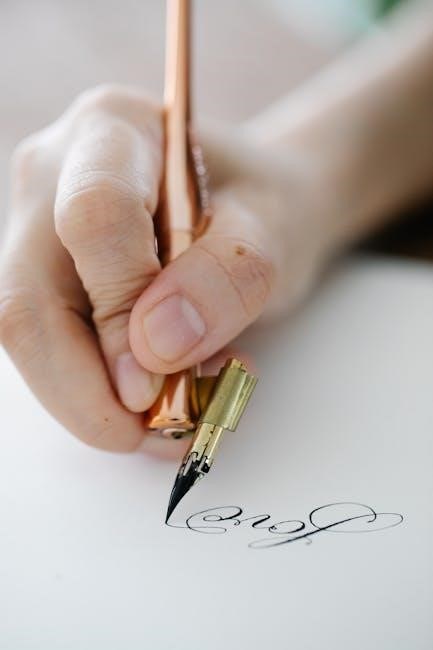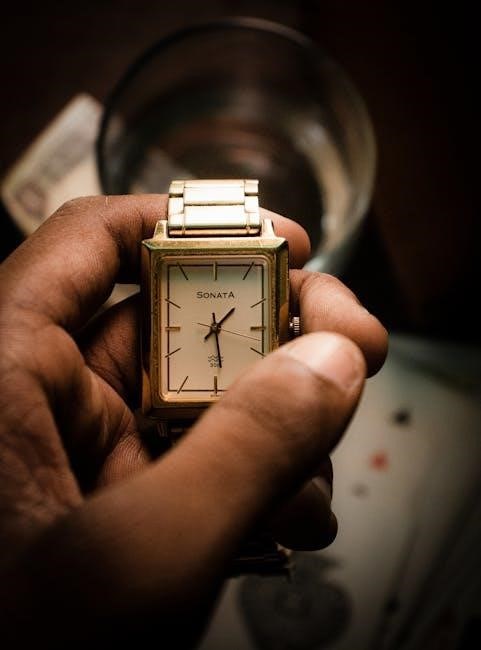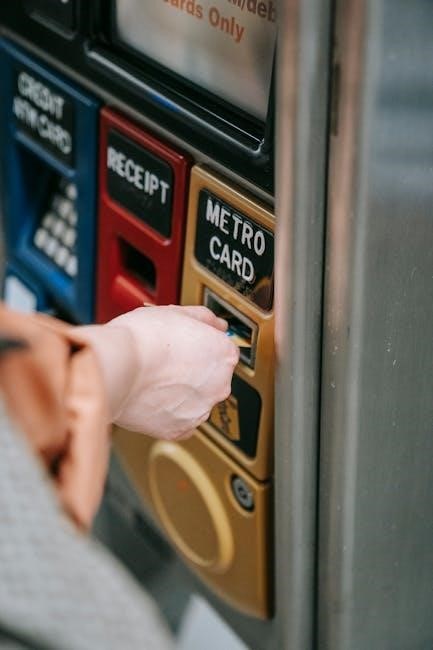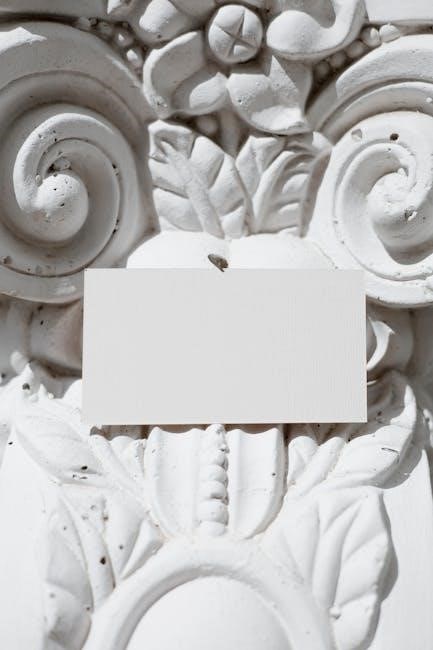A manual card shuffler is a tool designed to mix playing cards efficiently, ensuring randomness and fairness in games. Quiet, portable, and easy to use, it enhances card game experiences by providing consistent shuffling for games like poker, blackjack, and more.
1.1 What is a Manual Card Shuffler?
A manual card shuffler is a device designed to mix and randomize playing cards without the need for batteries or electricity. It typically operates via a lever, hand crank, or other mechanical mechanisms, making it easy to use and portable. These shufflers are suitable for standard or bridge-sized cards and can handle multiple decks, ensuring a fair and consistent shuffle. They are ideal for home use, casual gaming, and small gatherings, offering a reliable way to mix cards quietly and efficiently.
1.2 Importance of Card Shuffling in Games
Card shuffling is crucial for ensuring fairness and randomness in games, preventing predictability and cheating. It guarantees that each player has an equal chance of receiving any card, fostering trust and excitement. Proper shuffling is particularly vital in games like poker, blackjack, and Uno, where the outcome depends on unpredictability. Manual card shufflers provide a reliable method to achieve consistent results, enhancing the overall gaming experience and ensuring that every round is fair and enjoyable for all participants.
1.3 Brief History of Card Shuffling
Card shuffling traces its roots to ancient China, where playing cards first emerged. Early methods involved manual techniques like riffling and overhand shuffles. In the 1800s, mechanical devices began to appear, simplifying the process. The mid-20th century saw the development of manual card shufflers, designed for home use. These tools became popular among card enthusiasts, offering a reliable way to mix decks. Over time, manual shufflers evolved to accommodate multiple decks and improve efficiency. Today, they remain a staple in gaming, blending tradition with practicality, even as automatic and electronic shufflers gain prominence.

Evolution of Card Shuffling Technology
Card shuffling technology evolved from manual methods to automatic devices, with manual shufflers like CHH and KPAW emerging as efficient, portable solutions, blending tradition with modern design.
2.1 Early Methods of Card Shuffling
The earliest card shuffling methods involved manual techniques, such as hand shuffling, which was time-consuming and prone to human error. Over time, simple manual devices were developed to streamline the process. These early tools were rudimentary, often involving levers or cranks to mix cards more effectively. The invention of manual card shufflers marked a significant improvement, offering a more efficient and fair way to shuffle cards. This innovation laid the groundwork for the development of more advanced shuffling technologies, including automatic and electronic models.
2.2 Development of Manual Card Shufflers
The development of manual card shufflers introduced a more efficient way to mix cards, reducing reliance on tedious hand shuffling. Early models featured simple mechanisms like levers or cranks, designed to automate the shuffling process. These devices quickly gained popularity among card game enthusiasts due to their portability and ease of use. The CHH Hand-Cranked Card Shuffler, for instance, became known for its quiet operation and ability to handle multiple decks. This innovation marked a significant step forward in card shuffling technology, offering a practical solution for ensuring fair and random card distribution in various games.
2.3 Transition to Automatic and Electronic Shufflers
The evolution of shuffling technology led to the development of automatic and electronic shufflers, offering enhanced speed and efficiency. These devices use sensors and motors to shuffle cards with minimal human intervention, catering to high-volume users like casinos. The KPAW Automatic Card Shuffler, for example, supports multiple decks and features built-in gameplays, making it ideal for poker and other card games. While manual shufflers remain popular for their simplicity, automatic models have become the preferred choice for professional settings, ensuring faster and more consistent shuffling experiences.

Types of Manual Card Shufflers
Manual card shufflers come in lever-operated, hand-cranked, and handheld designs, each offering unique convenience for mixing cards efficiently in various card games like poker and blackjack.
3.1 Lever-Operated Shufflers
Lever-operated shufflers are a popular choice for mixing cards efficiently. These devices feature a simple mechanism where a lever is pressed to shuffle the cards. They are known for their portability and ease of use, making them ideal for casual gamers and professionals alike. Many models accommodate multiple decks, ensuring they can handle various card games. Lever-operated shufflers are particularly favored for their consistent shuffling results, which help maintain fairness in gameplay. Popular models include the CHH Hand-Cranked and KPAW Manual Shufflers, both designed for durability and smooth card mixing.
3.2 Hand-Cranked Shufflers
Hand-cranked shufflers are a traditional and reliable option for mixing cards manually. They feature a crank that users turn to shuffle the cards, offering a simple yet effective way to ensure randomness. These shufflers are often preferred for their ease of use and quiet operation. Designed for standard or bridge-sized cards, they are ideal for both casual and professional settings. Popular models, such as the CHH Hand-Cranked Card Shuffler, are known for their durability and smooth card handling. Hand-cranked shufflers are a practical choice for those seeking a manual, cost-effective solution for card games like poker, blackjack, and more.
3.3 Handheld Manual Shufflers
Handheld manual shufflers are compact, portable devices designed for easy card mixing. These lightweight tools are ideal for single-handed operation, making them perfect for travel or casual games. They typically feature a simple mechanism, such as a lever or sliding action, to shuffle cards quickly and efficiently. Many models accommodate standard or bridge-sized cards and are suitable for 1-2 decks. Their small size and ease of use make them a favorite among card game enthusiasts. Popular examples include portable shufflers that combine durability with smooth card handling, ensuring reliable performance for games like poker, blackjack, and more.

How to Use a Manual Card Shuffler
Using a manual card shuffler is simple. Place cards inside, turn the crank or press the lever, and let the device shuffle them for consistent randomness.
4.1 Step-by-Step Instructions for Lever-Operated Shufflers
Place the deck into the shuffler, ensuring it aligns with the guides. Gently press the lever down until it clicks, mixing the cards thoroughly. Repeat for desired randomness. Release the lever to collect the shuffled deck. This method ensures an even distribution, perfect for games requiring fair play.
4.2 Using Hand-Cranked Shufflers Effectively
Place the deck into the shuffler, ensuring cards align with the guides. Turn the crank gently but firmly to mix the cards thoroughly. For multiple decks, repeat the process. This method provides a quiet, portable solution for consistent shuffling, ideal for home games or travel. Regular use ensures even distribution and fair play, enhancing your card game experience.
4.3 Tips for Handling Multiple Decks
For handling multiple decks with a manual shuffler, start by placing one deck into the shuffler and shuffle thoroughly. Repeat the process for each additional deck, ensuring alignment to prevent jamming. To combine decks, shuffle one at a time, then mix them together. This method ensures even distribution and avoids overwhelming the shuffler; Regular cleaning and lubrication can improve performance with multiple decks. Portable designs make it easy to manage several decks during travel or home games, ensuring fair and consistent shuffling every time.
Advantages of Manual Card Shufflers
Manual card shufflers offer portability, ease of use, and quiet operation, making them ideal for home games, travel, and ensuring consistent shuffling results every time.
5.1 Portability and Convenience
Manual card shufflers are lightweight and compact, making them easy to carry to card games or events. Their small size allows for storage in bags or drawers. Additionally, they require no batteries, eliminating the need for charging or replacing power sources. This makes them ideal for travel or casual gatherings. Their simplicity ensures they are always ready to use, providing a reliable solution for quick, consistent shuffling without the hassle of electronic components. This convenience enhances the overall gaming experience for players of all skill levels.
5.2 Cost-Effectiveness
Manual card shufflers are highly cost-effective, offering an affordable solution for card enthusiasts. They are generally priced lower than automatic or electronic shufflers, making them accessible to casual players and professionals alike. Many models, such as the CHH Hand-Cranked Card Shuffler, are budget-friendly and durable, providing long-term value. With no need for batteries or complex maintenance, manual shufflers reduce additional expenses over time. Their simplicity ensures reliability without the high cost of advanced technology, making them a practical choice for anyone seeking a dependable shuffling tool without breaking the bank.
5.3 Consistent Shuffling Results
Manual card shufflers deliver consistent shuffling results, ensuring fair and random card distribution. Unlike manual shuffling by hand, which can introduce bias, these tools use mechanical actions to mix cards evenly. The CHH Hand-Cranked Card Shuffler, for example, employs a reliable mechanism to interleave cards thoroughly. This consistency is crucial for competitive games, where unpredictability is key. While some may argue that manual effort can lead to variability, high-quality shufflers are designed to minimize this, providing repeatable and accurate results with each use, enhancing the integrity of every game.

Disadvantages of Manual Card Shufflers
Manual card shufflers require physical effort, can be slow for multiple decks, and may lack consistency if not used properly, potentially affecting game fairness and efficiency.
6.1 Physical Effort Required
Using a manual card shuffler demands physical effort, as it requires turning a handle or pressing a lever repeatedly. This can lead to hand fatigue, especially during extended use. For individuals with limited hand strength or mobility, this may be a significant drawback. Additionally, shuffling multiple decks requires more force, making the process less convenient for larger games. While the effort is manageable for most, it can become tiresome over time, particularly for those accustomed to automatic or electronic shufflers.
6.2 Limited Capacity for Large Numbers of Decks
Manual card shufflers often have limited capacity, typically accommodating 2-4 decks at once. This makes them less practical for games requiring multiple decks, such as large-scale tournaments or high-stakes poker. Users needing to shuffle more decks must process them in batches, which is time-consuming and inconvenient. While suitable for casual use, manual shufflers are not ideal for professional settings where efficiency and handling large deck volumes are crucial. Their design focuses on simplicity and portability, sacrificing the ability to manage extensive deck numbers effectively.
6.3 Potential for Inconsistent Shuffling
Manual card shufflers can sometimes fail to mix cards thoroughly, leading to predictable patterns in games. This inconsistency arises from human error or improper technique, especially with complex shuffling methods. While they are reliable for casual use, they may not meet the precision required in competitive settings. Over time, wear and tear on the mechanism can exacerbate this issue, further reducing shuffling accuracy. Users must ensure cards are aligned properly and the shuffler is maintained well to minimize such inconsistencies and maintain fair gameplay.

Maintenance and Care
Regularly clean and lubricate your manual card shuffler to ensure smooth operation. Use a soft cloth to wipe down surfaces and apply silicone-based lubricant on moving parts.
7.1 Cleaning and Lubricating the Shuffler
Regular cleaning and lubrication are essential for maintaining your manual card shuffler. Turn off the device and unplug it before cleaning. Use a soft, dry cloth to wipe down the exterior and remove dust or debris. For internal components, gently brush away card dust using a small, soft-bristled brush. Apply a few drops of silicone-based lubricant to moving parts, such as gears or hinges, to ensure smooth operation. Avoid oiling areas where cards pass through to prevent residue buildup. Clean after each use and lubricate every 1-2 months for optimal performance.
7.2 Storage Tips to Prolong Lifespan
To extend the lifespan of your manual card shuffler, store it in a cool, dry place away from direct sunlight. Avoid exposure to moisture, as it can damage mechanical components. Keep the shuffler in its original packaging or a protective case to prevent dust and scratches. Store it upright to ensure balance and prevent warping. Avoid stacking heavy objects on top of the shuffler. Clean the device thoroughly before storage and ensure all moving parts are secure. Proper storage will help maintain its functionality and ensure it remains in excellent condition for future use.
7.3 Troubleshooting Common Issues
If your manual card shuffler malfunctions, check for jammed cards or debris. Ensure cards are aligned correctly and free from bends. Lubricate moving parts if they feel stiff. If cards are not shuffling evenly, adjust the tension on the rollers. For hand-crank models, inspect the handle and gears for wear. Replace worn parts promptly to maintain performance. Regular cleaning and maintenance can prevent many issues, ensuring smooth operation and extending the shuffler’s lifespan. Addressing problems early helps maintain reliability and keeps your games running smoothly without interruption.

Buying Guide for Manual Card Shufflers
Look for durable materials, smooth operation, and compatibility with standard or bridge-sized cards. Consider your budget and read reviews to find the best value for your needs.
8.1 Key Features to Look For
When selecting a manual card shuffler, prioritize features like compatibility with standard or bridge-sized cards, smooth and quiet operation, and durability. Opt for models with sturdy materials, such as metal or high-quality plastic, to ensure longevity. Consider the shuffler’s capacity, especially if you often use multiple decks. Additional features like compact design for portability and ease of use are also important. Some models include built-in card holders or trays for convenient loading. Ensure the shuffler is easy to clean and maintain. Always check if it supports the types of games you play, such as poker or blackjack.
8.2 Budget Considerations
Manual card shufflers vary in price, ranging from under $10 for basic models to over $50 for high-end designs. Consider your budget and how often you plan to use the shuffler. Simple, handheld models are cost-effective for casual use, while sturdier, multi-deck shufflers may be worth the investment for frequent gamers. Look for sales or discounts to get the best value. Brands like CHH and KPAW offer affordable options without compromising quality. Assess whether additional features justify higher costs or if a basic shuffler meets your needs. Balancing budget with functionality ensures a practical purchase decision.
8.3 Reading Reviews and Product Ratings
Reading reviews and product ratings is essential when selecting a manual card shuffler. Pay attention to feedback about build quality, ease of use, and performance. Look for mentions of durability and how well the shuffler handles multiple decks. Reviews often highlight whether a product is suitable for casual or frequent use. Additionally, check ratings from multiple sources to ensure consistency. This helps avoid low-quality or unreliable options. By prioritizing highly-rated products, you can make an informed decision and ensure the shuffler meets your needs for consistent and efficient card shuffling.

Popular Brands and Models
Popular brands include CHH, known for hand-cranked shufflers, and KPAW, offering manual models. These brands provide durable, easy-to-use designs for standard or bridge-sized cards, ensuring quiet operation.

9.1 CHH Hand-Cranked Card Shuffler
The CHH Hand-Cranked Card Shuffler is a reliable choice for mixing standard or bridge-sized decks. Its compact design and smooth operation make it ideal for home use or small gatherings. Users appreciate its quiet performance and ease of handling multiple decks. The shuffler is built with durable materials, ensuring long-lasting use. It’s a favorite among casual gamers and professionals alike, providing consistent shuffling results every time. The CHH model stands out for its affordability and efficiency, making it a top pick for those seeking a manual shuffler.
9.2 KPAW Manual Card Shuffler
The KPAW Manual Card Shuffler is a versatile and efficient tool for mixing 1-2 decks of standard or bridge-sized cards. Designed for ease of use, it features a compact build and smooth operation, making it ideal for both casual and professional settings. The shuffler supports multiple game types, including poker, blackjack, and UNO, and is known for its consistent shuffling results. Its durable construction ensures long-term reliability, while its portability makes it a great choice for on-the-go use. The KPAW model is a top recommendation for users seeking a reliable manual shuffler.
9.3 Other Notable Brands
Beyond CHH and KPAW, other notable brands in the manual card shuffler market include Brybelly and Nordic Games. Brybelly is known for its durable construction and smooth operation, making it a favorite among card enthusiasts. Nordic Games offers innovative designs that cater to both casual and professional users. These brands provide reliable performance, ensuring consistent shuffling for various card games. They are popular for their portability and ease of use, making them excellent choices for home and travel. Each brand brings unique features to the table, offering users a wide range of options to suit their preferences and needs.

Comparison with Automatic Shufflers
Manual shufflers offer portability and cost-effectiveness, while automatic shufflers provide speed and efficiency. Manual requires effort but is budget-friendly, whereas automatic handles multiple decks effortlessly but costs more.
10.1 Speed and Efficiency
Automatic shufflers excel in speed, handling multiple decks swiftly and consistently, making them ideal for high-stakes games. Manual shufflers, while effective, are slower and require physical effort, making them less efficient for large groups or frequent shuffling needs.
10.2 Reliability and Consistency
Manual card shufflers offer reliable performance for small-scale use, ensuring consistent shuffling with proper handling; However, automatic shufflers outperform manuals in consistency, using advanced mechanisms to minimize human error. While manual shufflers are durable and easy to maintain, automatic models often include smart sensors for precise card detection, enhancing reliability. For high-stakes games, automatic shufflers are preferred due to their ability to deliver consistently randomized results, whereas manual shufflers may vary slightly based on user technique and fatigue.
10.3 Cost and Maintenance Differences
Manual card shufflers are generally more affordable than automatic or electronic models, with prices often ranging between $10 to $30. Automatic shufflers, while offering greater convenience, can cost $50 to $100 or more. Maintenance for manual shufflers is minimal, requiring occasional cleaning and lubrication. Automatic shufflers, however, may need more frequent upkeep due to their complex mechanisms. Over time, manual shufflers prove more cost-effective for casual users, while automatic models are better suited for high-volume or professional settings where speed and durability justify the higher investment.
Manual card shufflers offer a cost-effective, portable, and easy-to-use solution for mixing cards, ideal for casual and serious gamers alike, ensuring consistent shuffling every time.
11.1 Final Thoughts on Manual Card Shufflers
Manual card shufflers are practical tools for ensuring fair and random card distribution in various games. Their portability, ease of use, and cost-effectiveness make them ideal for both casual and serious gamers. While they require physical effort, they provide consistent shuffling results, enhancing the overall gaming experience. With minimal maintenance and durability, they remain a reliable choice for card enthusiasts; Whether for home use or small gatherings, manual shufflers offer a straightforward solution for mixing decks efficiently, making them a worthwhile investment for anyone who values simplicity and effectiveness in their card games.
11.2 Recommendations for Different Users
Manual card shufflers are ideal for casual gamers seeking a simple, cost-effective solution. For serious players or professionals, high-quality models with consistent shuffling are recommended.Those hosting parties or events may benefit from shufflers that handle multiple decks. Beginners should opt for easy-to-use designs, while experienced users might prefer advanced features. Consider deck size, portability, and durability when selecting a shuffler. Ultimately, the choice depends on individual needs, ensuring an enhanced gaming experience for all users.

